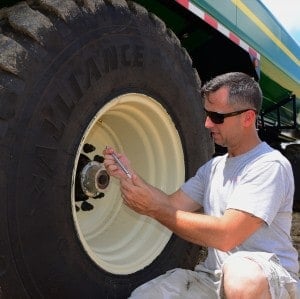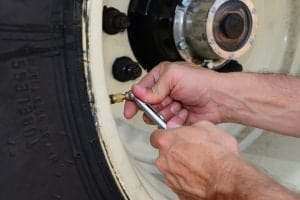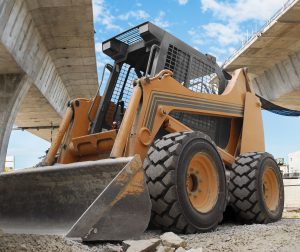It’s not easy to be a tire in a waste management operation—but it’s a vital job. Here are some easy tips for keeping tires in tip-top shape.
Steve Vandegrift
Chances are, you probably haven’t thought much about tires today. Tires tend to be the sort of thing facility managers and equipment operators start thinking about when there’s a problem. But a few minutes a day spent on tire maintenance can prevent hours spent unraveling problems in the future … and it can start improving your bottom line immediately.
Start With A Fresh Gauge
It just takes a moment to check the air in a tire. Just make sure you’re starting with a reliable air gauge. In fact, it’s a good idea to replace your air gauges every year. Otherwise, worn springs, old seals, corrosion or dirt inside the gauge, or other problems can fool you into operating at the wrong inflation pressure.
Let’s start a new tradition. When you go out to buy Halloween candy—this year and every Halloween from now on—stop by your auto supply shop and pick up new tire gauges.
Determine Optimum Pressure
Make sure the pressure is adequate for the load on the wheel. (Not sure what the pressure should be? Consult the tire manufacturer’s inflation tables for your tire.)
When you calculate load, make sure you’re considering not just the weight of the machine, but also the weight of its cargo or of what it’s lifting. Think about where load is concentrated—for instance, a bucket loader bears more weight on the wheels closest to the bucket, while a machine pulling a trailer will have greater pressure on the wheels by the hitch or drawbar. Also be sure to consider whether the machine will be operating on slopes. A vehicle on a hillside will put significantly more load on its downhill tires than on its uphill ones. That can be an especially big problem on side slopes, which can severely stress beads and sidewalls.
Avoid Underinflation
Underinflated tires are a problem on a couple of levels. Air is what carries the load—the tire’s main purpose is to hold the air. Underinflation means there isn’t enough air to do the job. Your tire will try to take up the slack, but it will be working beyond its capacity. Beads can unseat, sidewalls can get damaged, and in the case of severely underinflated tires, your rims can even score the carcass.
Sagging sidewalls are also more prone to getting perforated by sharp debris or pinched. And when sidewalls aren’t supported by adequate air pressure, they flex excessively, creating heat, which, in turn, can destroy the tire. (Those “road alligators” you see along the highway are generally tires that ran underinflated, overheated and fell apart at high speed.)
Don’t Overinflate
Overinflation is no bargain, either. While it minimizes the flexing that generates heat, overinflation minimizes the amount of tread in contact with the ground, reducing the efficiency of the tire. It also prevents the tire from bending to envelop debris like rocks or broken pavement, reducing its ability to withstand damage. The result could be a blowout from a rock that would otherwise just have felt like a bump to the operator.
Overinflated tires also provide a hard ride. That can be tough on machinery, accelerating wear on suspensions, frames, towed equipment and other components. It can also be tough on operators, increasing fatigue and lowering their operating efficiency.
Store Tires Properly
If you’re not using a set of tires and need to store them, make sure you are storing them properly. Sunlight and oil can break down rubber compounds, so keep tires clean and sheltered. A cool, dry place is best for storing tires.
Storing tires near electric motors can also be a major problem. Electric motors generate ozone, a gas that eats into rubber compound and weakens the molecular bonds that hold your tires together.
The Most Profitable Thing
Maintaining tires isn’t difficult. It doesn’t even eat up a lot of time. But it could save you time, money and stress, which makes it one of the most profitable things you do today.
Steve Vandegrift is Product Manager for Alliance Tire Americas, part of the global Alliance Tire Group. Steve started his career in the tire business in the Galaxy warehouse and is now a walking encyclopedia of knowledge on industrial, construction, forestry and agricultural tires. He oversees the Galaxy and Primex brands for Alliance. Steve can be reached at (781) 321-3190 x210 or [email protected].



